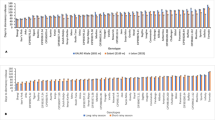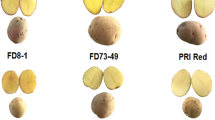Conclusions
-
1.
Sprout growth is continuous at the apical eye of potato tubers after harvest. There is no incapacity for growth, but this growth is not visible to the naked eye as a sprout for a period of time, depending on the storage conditions
-
2.
Temperature is the prime factor in controlling the length of the period from harvest to minimal visible sprouting; humidity may have some effect in the lower temperature range but light has no effect
-
3.
Cool storage at 35–40° F is ideal from the point of view of the soundness of the end product and minimum sprout growth. Where tubers are stored for seed purposes at higher temperatures light access is essential to prevent etiolation
-
4.
In general, the warmer the storage conditions the earlier is tuberization and maturity with a lower final yield than cooler-stored tubers
Similar content being viewed by others
Literature Cited
Emilsson, B. 1949. Studies on the rest period and dormant period in the potato tuber, Acta Agriculturae Suecana III: 3.
Wright, R.C., and W. M. Peacock. 1934. Influence of storage temperatures on the rest period and dormancy of potatoes. U.S.D.A. Tech Bull. 424.
Loomis, W. E. 1927. Temperature and other factors affecting the rest period of potato tubers. Plant Phys. 2:287–302.
Koltermann, A. 1927. Die Keimung der Kartoffelknolle und ihre Beeinflussung durch Krankheiten. Angew Bot., 9: 289–339.
Rosa, J. T. 1928. Relation of tuber maturity and of storage factors to potato dormancy. Hilgardia 3: 99–124.
Stuart, W. and E. H. Milstead. 1934. Shortening the rest period of the potato. U.S.D.A. Tech Bull. 415.
Thornton, N. C. 1939. Oxygen regulates the dormancy of the potato. Contr. Boyce Thompson Inst. 10:339–361.
Sawyer, R. C. and O. Smith 1955. A study of the oxygen-periderm relationship in potato tubers and the effect of oxygen on the normal breaking of the rest period. Amer Potato Jour. 32:15–22.
Smith, O. 1955. How to grow and store potatoes for the chip industry. Amer. Potato Jour. 32:265–271.
Todd, J. Mc A. 1952–1953. Annual report of the Plant Pathology Section. Department of Agriculture for Scotland.
Author information
Authors and Affiliations
Rights and permissions
About this article
Cite this article
Davidson, T.M.W. Dormancy in the potato tuber and the effects of storage conditions on initial sprouting and on subsequent sprout growth. American Potato Journal 35, 451–465 (1958). https://doi.org/10.1007/BF02851270
Accepted:
Issue Date:
DOI: https://doi.org/10.1007/BF02851270




